Netgear A6200 802.11ac USB Wi-Fi Adapter Review
Netgear A6200: Wireless-AC Speed Tests
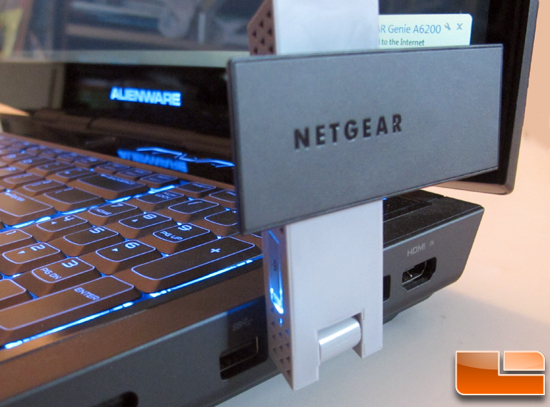 To test the throughput of the Netgear A6200, we paired it with a Netgear R6300 Dual-Band 802.11ac wireless router that is our current Legit Reviews Editors Choice. We wanted to see a real-world application so we took our Alienware M17XR4 gaming laptop and installed the Netgear A6200 to conduct our speed tests. The Alienware M17XR4 is already one of the best laptops on the market today in part because it features an Intel i7-3610QM CPU with 6GB RAM running Windows 7 64-Bit, and an NVIDIA GeForce GTX 660M. More importantly it is outfitted with a Qualcomm Antheros Killer Wireless-N 1103 Network Adapter already. The Killer 1103 is a three-antenna network adapter that connects at up to 450Mbps over 802.11n. We have written about the Killer NIC technology in recent years and there is no doubt that this 3-antenna solution will give us the best possible wireless-n throughput for our test.
To test the throughput of the Netgear A6200, we paired it with a Netgear R6300 Dual-Band 802.11ac wireless router that is our current Legit Reviews Editors Choice. We wanted to see a real-world application so we took our Alienware M17XR4 gaming laptop and installed the Netgear A6200 to conduct our speed tests. The Alienware M17XR4 is already one of the best laptops on the market today in part because it features an Intel i7-3610QM CPU with 6GB RAM running Windows 7 64-Bit, and an NVIDIA GeForce GTX 660M. More importantly it is outfitted with a Qualcomm Antheros Killer Wireless-N 1103 Network Adapter already. The Killer 1103 is a three-antenna network adapter that connects at up to 450Mbps over 802.11n. We have written about the Killer NIC technology in recent years and there is no doubt that this 3-antenna solution will give us the best possible wireless-n throughput for our test.
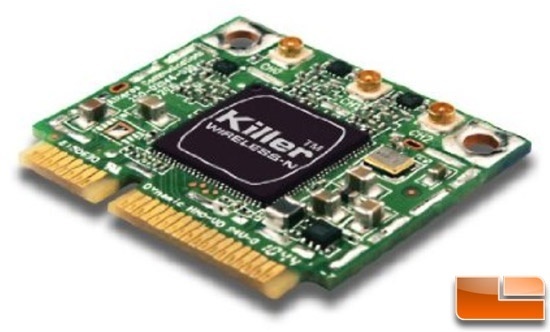
Using the Netgear 802.11ac adapter should give us a nice comparison to what a user can expect in terms of performance step up.
As we have with our other wireless networking tests, we took our Alienware laptop connected to the Netgear A6200 Dual-Band Adapter and moved it 25-feet away from our Netgear R6300 802.11ac router. We didn’t tell the client anything more than the 5Ghz SSID name for the router and let it automatically choose the channel to connect to. For more of a comparison to everyday laptops, we took a Dell Latitude E6410 laptop with an Intel Centrino Advanced-N 6200 AGN Wireless Adaptor and tested it against our Netgear A6200, the Killer NIC and the ASUS USB-AC53 that we tested recently. The Intel Centrino 6xxx series has been one of the most widely used mobile networking solutions ever. We set the router to Unsecure Mode (for fastest data throughput), and with WMM / QoS turned ON. After connecting, we ran the PC application LAN Speed Test (LST) to measure file transfer and network speeds.
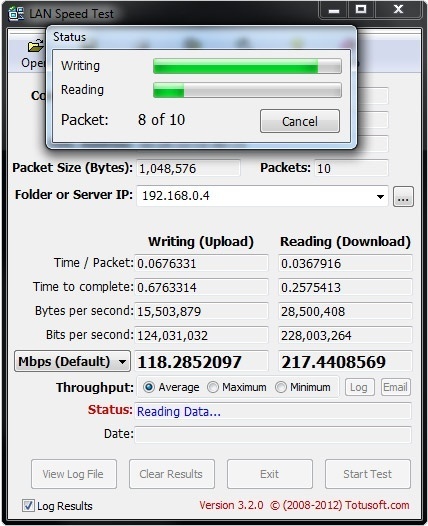
LST builds a file in memory and then transfers the packet without the effects of windows file caching. It then reports the time and calculates the network speed. We repeated the test 2 more times rotating the AC adapter 90 degrees after each test to make sure that the speed wasnt affected adversely by orientation.
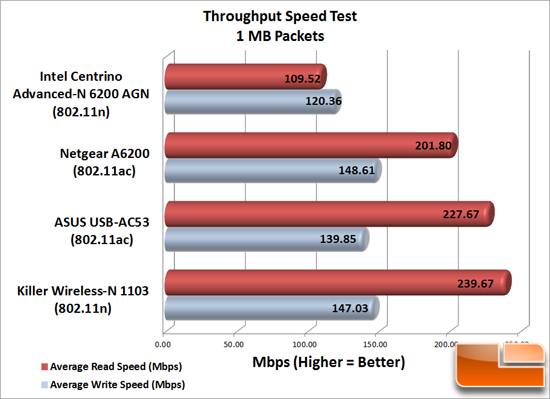
Benchmark Results: Looking at the tests for our smallest data packet, we see that Qualcomm Atheros Killer Wireless holds its own outpacing the Netgear A6200 by almost 19% in Average Read Speeds. Write speeds performance are almost identical. The results are split when looking at the Netgear adapter against the ASUS USB-AC53. The ASUS is 13% faster than the Netgear in Average Read Speeds, but the Netgear is only 6% faster than the ASUS in Average Write Speeds. Both the Netgear A6200 and ASUS USB-53 are tremendously faster than our Intel Centrino 6300AGN.
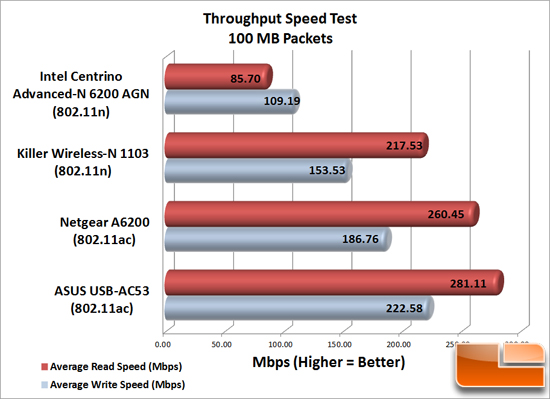
Benchmark Results: We consider the speed tests with 100 MB data to be the most significant because this packet size simulates streamed multimedia via wireless. Looking at the tests for these sized data packet, we see that the the ASUS USB-AC53 adapter is 8% faster than the Netgear A6200 USB adapter. Both of these speeds are significantly better than our stock Intel Centrino Advanced-N wireless adapter. The Qualcomm Atheros Killer Wireless puts in a solid performance, but anyone can see that there are significant speed advantages to upgrading to 802.11ac no matter where you start.

Comments are closed.